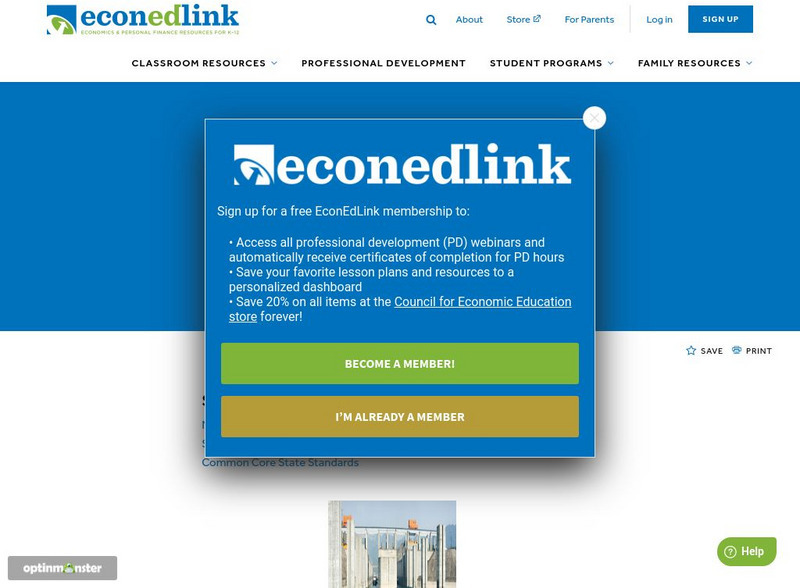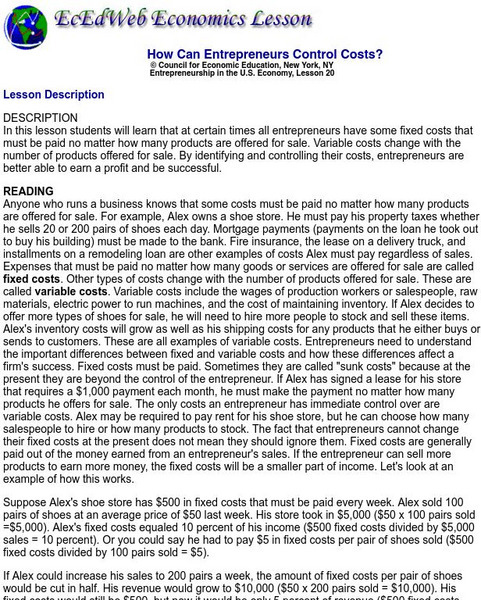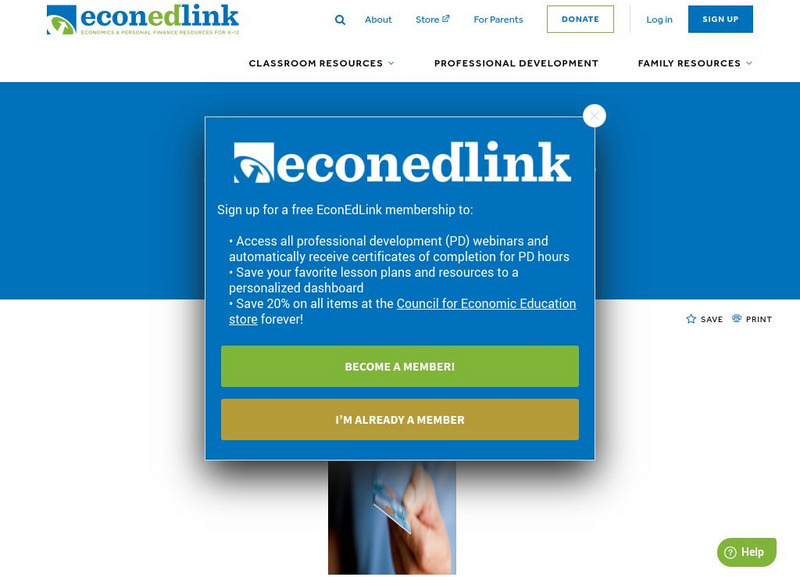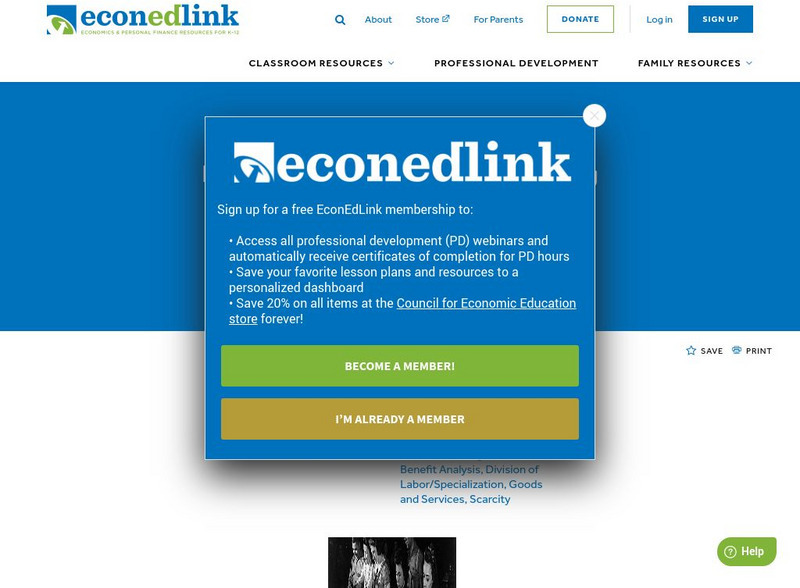Curated OER
Tortilla Factory
Students identify productive resources and intermediate goods used to produce corn tortillas. In this productive resources lesson, students listen to the book Tortilla Factory and classify resources used to make paper tacos.
Curated OER
Popcorn Economics
Students examine the concept of scarcity. In this economics lesson plan, students define scarcity and take part in an activity that illustrates the concept as it relates to goods and services.
Curated OER
The Goat in the Rug
Students define productive, capital, human and natural resources and intermediate goods, then classify these things by how they are used in a production process. In this resources/goods lesson plan, students listen to the story The Goat...
Curated OER
How Resourceful Are You?
Students investigate the concept of resources. They differentiate between natural, human, and capital resources. Prior to the lesson the students need to build background knowledge of goods, services, needs, and wants. They create a...
Curated OER
Teaching Economics Using LUNCH MONEY
Students, after reading the book "Lunch Money" by Andrew Clements, explore money and different saving places. They research different ways in which productivity has increased over the years, they examine products to determine if the...
Curated OER
How Resourceful Are You?
Students examine the Nevada state quarter and discuss items on the quarter, categorizing them as natural resources, human resources, or capital resources. They paste other coins into correct categories depending on the resources depicted...
Curated OER
Edwin Perkins: A Nebraska Success Story
Fourth graders explore the life of the inventor of Kool-Aid to unearth concepts of a market economy. Vocabulary presented helps support the learning process.
Curated OER
Resources of the Three Little Pigs
Second graders, after listening to the The Three Little Pigs, identify the natural, human, and capital resources involved in creating each house.
Council for Economic Education
Econ Ed Link: The Shoemaker's Tools
This lesson incorporates the folk tale of The Shoemaker and the Elves to teach your students about the concept of capital resources. Lesson contains a link to an animated retelling of this beloved classic. Use it to have students...
Council for Economic Education
Econ Ed Link: Music, Maestro, Please: Show Business and the Factors of Production
The city of Philadelphia, Pennsylvania recently opened a $300 million dollar center for the performing arts, the Kimmel Center. This lesson was developed for a special teacher workshop to incorporate economics and the arts to teach kids...
Council for Economic Education
Econ Ed Link: Lemonade for Sale!
Middle schoolers will become online entrepreneurs, taking risks and changing their production method to increase their profit while running a lemonade stand. This lesson might best be taught after students have learned about the basic...
Council for Economic Education
Econ Ed Link: The Civil War: A War of Resources
The North won the Civil War in large part due to its superior resources. In this lesson students will learn the difference between capital resources, human capital, and natural resources. They will investigate and compare the resources...
Council for Economic Education
Econ Ed Link: Cost/benefit Analysis: Three Gorges Dam
This lesson will allow middle schoolers to evaluate the costs/benefits of the Three Gorges Dam project on the Yangtze River in China. The purpose of this lesson is to encourage students to look at a complex issue from differing...
Council for Economic Education
Econ Ed Link: Capital Chips (Part 2)
Through the use of a historical timeline of the capital investments made by the company the resulting benefits will be examined. The benefits from the capital investments of Herr Foods, Inc. will be related to their effect on the...
Council for Economic Education
Econ Ed Link: Capital Chips (Part 1)
Through the use of a historical timeline of the capital investments made by the company the resulting benefits will be examined. The benefits from the capital investments of Herr Foods, Inc. will be related to their effect on the...
Council for Economic Education
Econ Ed Link: The Economics of Income: The Rich Nations Mystery
Why are some countries very wealthy and others so poor? In this lesson you will learn about the factors that contribute to a nation's standard of living.
Council for Economic Education
Econ Ed Link: Human Resources and Capital Resources: It's a Match!
Students will define and identify human resources and capital resources workers use in their jobs.
Council for Economic Education
Econ Ed Link: Booker T. Washington:"fifty Cents and a Dream"
Young Booker T. Washington had a dream. That dream was to use the resources at his disposal to earn the money necessary to get an education that would allow him and others to become financially secure. This lesson based on the picture...
Council for Economic Education
Econ Ed Link: Mystery Workers: Productive Resources
This website focuses on productive resources which are divided into three categories, natural, human, and capital.
University of Nebraska Omaha
Ec Ed Web: How Can Entrepreneurs Control Costs?
This economics activity explores what influences producers to supply in regard to demand. It examines fixed and variable costs, how such costs can be reduced, and how they influence production. Includes printable worksheets.
Council for Economic Education
Econ Ed Link: The Economics of Income: Which 'Wood' You Choose?
A key turning point in a nation's economic development is when it starts to use its resources for long term versus short term purposes. A natural resource example is trees: should people use wood for cooking food or building homes?...
Council for Economic Education
Econ Ed Link: Those Golden Jeans
Check out this informative economics lesson plan designed to review the three productive resources--natural resources, human resources, and capital resources--needed to produce goods and services.
Council for Economic Education
Econ Ed Link: My Credit Rating: Why Should I Care?
Credit is a wonderful tool for the consumer. It can enhance your quality of life. It enables you to buy and enjoy a purchase before you have the money to pay for it. On the other hand, it can create serious problems for people who use it...
Council for Economic Education
Econ Ed Link: Economic Spotter: Resources During World War Ii
In World War II pennies were made of steel and zinc instead of copper and women were working at jobs that men had always been hired to do. Why? Because during war times, scarcity forces many things to change!


















